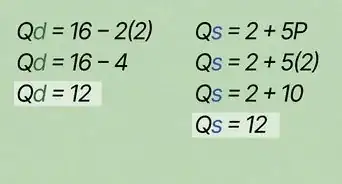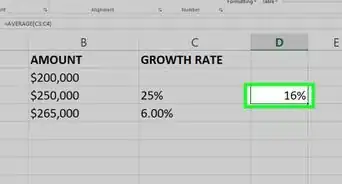This article was co-authored by Michael R. Lewis. Michael R. Lewis is a retired corporate executive, entrepreneur, and investment advisor in Texas. He has over 40 years of experience in business and finance, including as a Vice President for Blue Cross Blue Shield of Texas. He has a BBA in Industrial Management from the University of Texas at Austin.
There are 12 references cited in this article, which can be found at the bottom of the page.
This article has been viewed 248,726 times.
An annuity is a type of investment that is usually handled by an insurance company. An investor will invest her money in an annuity fund in exchange for periodic payouts over a predetermined interval (such as for the next ten years) or indefinitely (for the rest of your life).[1] Some annuities provide the option of getting immediate payment.[2] However, if you are in a financial emergency and require immediate cash, you might have to cash out an annuity early. While there may be hefty fees involved, particularly if your annuity is held within a retirement account like an IRA or 401k, it is possible to get immediate cash from your annuity investment.
Steps
Getting Cash from an Immediate Annuity
-
1Consider carefully whether you need immediate cash. Investments work best when they are allowed to grow over the long term. Withdrawing cash early from an annuity brings with it a risk of fees and will significantly harm the long-term potential of your investment. Consider very carefully whether you are in a true financial emergency before taking steps to sell an annuity, and be sure to use early withdrawal options only as a last resort.
-
2Think about other options for immediate cash. Because of the potential penalties of getting cash from an annuity, consider other options for getting cash during a financial emergency. Many of these options come with lower risks and few to no financial penalties. These include:
- Take out a short-term, unsecured loan (a loan without collateral) from your bank or a local credit union.
- Renting out a room via AirBNB or another website.
- Sell unwanted items online.
- Take on an additional part-time job or side gig, such as babysitting, dogsitting, or working retail.
- Get a Home Equity Loan. These loans will require interest payments, but they might be lower than the penalties you would pay for cashing in an annuity.
Advertisement -
3Determine exactly how much money you need. In some cases, you might be able to receive small, immediate cash payouts from your annuity without too many penalties and fees. However, if you need to cash in your entire annuity, you will likely pay some hefty fines. Therefore, it is important that you know exactly how much cash you need to get through your financial emergency. By only taking out the money you absolutely need, you might be able to be more financially stable in the long run.
-
4Determine whether you have an immediate or deferred annuity. An immediate annuity will provide monthly, quarterly, or annual cash payments to the investor immediately after the investment is purchased. A deferred annuity, however, allows the investment to grow for a period of some years before the payouts begin.[3]
- If you have an immediate annuity already, you can simply collect your cash installments at the appropriate intervals. Depending on how much cash you require, these installments might be sufficient for your needs.
- When payments are made, annuities are taxed on the earning portion of the asset, not a return of principal.
- Additionally, an immediate annuity within a retirement account, like a Roth IRA, can provide penalty-free payments to persons under 59.5 years of age.[4]
-
5Convert a deferred annuity to an immediate annuity. This option is one that many investors consider as they transition into retirement. They use the deferred annuity to grow their money over the long-term and then convert into an immediate annuity to guarantee an income stream during their retirement. If you convert your deferred annuity to an immediate annuity, you might have the best of both worlds: immediate access to some cash while still allowing your investment portfolio to grow.
- Depending on when you purchased your deferred annuity, however, it might be costly for you to pursue the conversion option. Make sure you discuss fees and penalties carefully with your insurance company and your financial advisor before undertaking a conversion.
-
6Collect your cash payments without penalty. If you have an immediate annuity, you will receive several small payments each year. This option is a good one for those who are in immediate need of cash (such as those who are on a fixed income). And as long as you only collect the amount specified in your contract, you can do so without paying extra fees.
-
7Determine your surrender period. A surrender period is the period of time after the initial purchase of the annuity where you will be charged hefty fees for cashing out your plan. A surrender period can be anywhere from 5-10 years after purchase, depending on your contract, though it is usually between 6-8 years.
- If your surrender period has passed, you might be able to cash out your annuity without paying too many fees.
- If your surrender period has not yet passed, you might want to consider the expenses involved before continuing the early withdrawal process.
-
8Decide to sell your immediate annuity. Unlike deferred annuities, most immediate annuities do not provide an option for small-sum early withdrawals or partial sales. You will likely have the opportunity, however, to sell the entire immediate annuity for a lump-sum.[7] Again, reserve this option as a last resort given the hassle and fees involved in cashing out your immediate annuity early.
-
9Be aware of possible financial penalties. Withdrawing cash from your annuity early can lead to hefty penalties, taxes, and fines. Be sure that you take these penalties into account before making your decision to withdraw your cash.[8]
- If your annuity is part of a retirement account and you withdraw your money before you are 59.5 years old, you will have to pay a 10% early withdrawal fee to the federal government.[9]
- If you withdraw your money within the first 5-8 years of purchase, you will likely have to pay a "surrender fee" to your insurance company. The exact fee amount depends on your contract. Many surrender fees begin at about a 7% penalty for the first year after purchase and decrease over time from there. However, some companies might charge a fee as high as 20%.[10]
- Cash you receive from annuities counts as income. You will likely have to pay income taxes in addition to the early withdrawal fees and surrender fees. The one exception is that payments from an annuity as part of a Roth IRA are not taxable.
-
10Research companies that offer cash in exchange for annuity payments. None will give you the full value of your future payments. They might offer anywhere from 60% to 85% of the value of your annuity. Getting 85% of your annuity’s value would be considered a fairly good offer. Since you are legally transferring your rights, you want a company that follows standard procedures and will prepare you for any required court proceedings.
- Understand that you are not getting a good deal here because the company you are selling to has to make a profit. Annuity sale prices are reached by discounting a series of future cash flows by some interest rate. Typically, a buyer will use a lower rate than is earned in the annuity to make a profit themselves. This results in a lower sale price for you.
-
11Consult your tax attorney or financial advisor. Before agreeing to sell your annuity to a third party, consult a trusted legal or financial expert. They will help you determine your financial liability and help you navigate through the complicated contracts you might have to sign. This will help to ensure that you understand what is happening and that it is done correctly. They might also be able to help guide you to the most reputable companies that purchase annuities.
-
12Collect your documents. Documents required for the sale of an annuity include two forms of identification, your initial annuity policy, and an application to sell your annuity to a third party. You might have to contact your insurance company in order to receive correct, up-to-date copies of your paperwork.[11]
-
13Complete the transaction. Upon submitting your paperwork and paying your fees and penalties, you will be able to receive your cash payout. Make sure that you report this income correctly during tax time and that you pay all the extra taxes on this money to avoid future penalties.
- You might want to consider discussing your finances with a financial advisor to ensure that you will use and invest the cash payout properly.
Getting Cash from a Deferred Annuity
-
1Determine what kind of annuity you hold. There are three kinds of annuity, each one of which pays out money slightly differently. The U.S. Securities and Exchange Commission (SEC) regulates all variable annuities and some index annuities. The SEC does not regulate fixed annuities.[12]
- A fixed annuity pays out a predetermined amount at specific intervals over a period of time. This amount is usually based on a specific interest rate applied to your initial investment.[13]
- An indexed annuity provides payment to the investor based on the performance of a stock market index fund (or, a fund that tracks the entire stock market performance). Most indexed annuities, however, have a set minimum for payments even if the index fund performs poorly.[14]
- A variable annuity allows the investor to choose amongst various investment vehicles, usually mutual funds. Your periodic payment will depend upon the performance of these investments.[15]
-
2Determine the type of account your annuity is held in. In addition to the different types of annuity payments, annuities can be held in various types of accounts for certain purposes. These typically include investment and retirement accounts. Both types operate generally the same way, however, they may differ in early withdrawal and tax penalties charged. Check your investment documents or retirement plan agreement to see what type of penalties and restrictions there are on your annuity.
-
3Consider penalty-free early withdrawal options. Some deferred annuity policies provide an option for small cash withdrawals without extra penalties. For example, a withdrawal of 5-10% of your initial investment might be accomplished without paying a "surrender fee" to your insurance company. While taking an early withdrawal will diminish your investment's ability to grow, you might be able to get the cash you need without completely emptying your annuity.[16]
- If your annuity is part of a retirement account and you are under 59.5 years old, you might still have to pay a 10% tax to the federal government, even if you don't have to pay a penalty to your insurance company.
-
4Determine your surrender period. A surrender period is the period of time after the initial purchase of the annuity where you will be charged hefty fees for cashing out your plan. A surrender period can be anywhere from 5-10 years after purchase, depending on your contract, though it is usually between 6-8 years.
- If your surrender period has passed, you might be able to cash out your annuity without paying too many fees.
- If your surrender period has not yet passed, you might want to consider the expenses involved before continuing the early withdrawal process.
-
5Reread your annuity contract. Review the details of your annuity contract. Pay attention to the full-disclosure clause of your agreement. It’s important that you understand what portion of your annuity payments you are exchanging for a lump-sum cash payment.
-
6Understand the process. If you are seeking a lump sum of cash in lieu of structured payments, you are in effect signing over to someone else all your rights to receive future annuity payments. That "someone else" is the entity giving you the lump-sum cash.
- Be aware that in the long term your annuity is worth much more if you receive structured payments according to the original contract. Talk to your insurance agent to determine the exact worth of your annuity. You may decide to ride out your immediate cash-flow crisis instead of cashing in.
-
7Be aware of possible financial penalties. Withdrawing cash from your annuity early can lead to hefty penalties, taxes, and fines. Be sure that you take these penalties into account before making your decision to withdraw your cash.[17]
- If your annuity is part of a retirement account and you withdraw your money before you are 59.5 years old, you will have to pay a 10% early withdrawal fee to the federal government.[18]
- If you withdraw your money within the first 5-8 years of purchase, you will likely have to pay a "surrender fee" to your insurance company. The exact fee amount depends on your contract. Many surrender fees begin at about a 7% penalty for the first year after purchase and decrease over time from there. However, some companies might charge a fee as high as 20%.[19]
-
8Research companies that offer cash in exchange for annuity payments. None will give you the full value of your future payments. They might offer anywhere from 60% to 85% of the value of your annuity. Getting 85% of your annuity’s value would be considered a fairly good offer. Since you are legally transferring your rights, you want a company that follows standard procedures and will prepare you for any required court proceedings.
-
9Consult your tax attorney or financial advisor. Before agreeing to sell your annuity to a third party, consult a trusted legal or financial expert. They will help you determine your financial liability and help you navigate through the complicated contracts you might have to sign. This will help to ensure that you understand what is happening and that it is done correctly. They might also be able to help guide you to the most reputable companies that purchase annuities.
-
10Collect your documents. Documents required for the sale of an annuity include two forms of identification, your initial annuity policy, and an application to sell your annuity to a third party. You might have to contact your insurance company in order to receive correct, up-to-date copies of your paperwork.[20]
-
11Complete the transaction. Upon submitting your paperwork and paying your fees and penalties, you will be able to receive your cash payout. Make sure that you report this income correctly during tax time and that you pay all the extra taxes on this money to avoid future penalties.
- You might want to consider discussing your finances with a financial advisor to ensure that you will use and invest the cash payout properly.
Warnings
- Consult your tax attorney or accountant before selling. If you sell too early, you may be liable for a hefty surrender charge, and if you sell before you have reached the age of 59-and-a-half, you will probably be faced with federal taxes and penalties.⧼thumbs_response⧽
- Thoroughly research any company offering to purchase your annuity. You can research any formal complaints filed against a company by contacting the Better Business Bureau.[21] It’s a good idea to ask your tax accountant for recommendations as well.⧼thumbs_response⧽
- Do not purchase an annuity unless you have a decent emergency savings account that you can access easily and without penalty. An annuity is not a suitable emergency fund because of the fees, delays, and hassles in receiving quick cash.[22]⧼thumbs_response⧽
- To avoid fraud, make sure you purchase an annuity from a reputable, licensed company.[23]⧼thumbs_response⧽
References
- ↑ http://money.cnn.com/retirement/guide/annuities_basics.moneymag/
- ↑ http://money.cnn.com/retirement/guide/annuities_basics.moneymag/index2.htm?iid=EL
- ↑ http://money.cnn.com/retirement/guide/annuities_immediate.moneymag/index.htm?iid=EL
- ↑ https://www.immediateannuities.com/annuity-library/early-withdrawal-pre-59-exceptions.html
- ↑ http://www.sec.gov/answers/annuity.htm
- ↑ http://investor.gov/investing-basics/investment-products/annuities#Buy%20and%20sell
- ↑ http://learnbonds.com/13873/selling-annuities/
- ↑ http://www.sec.gov/answers/annuity.htm
- ↑ http://money.cnn.com/retirement/guide/annuities_basics.moneymag/index9.htm?iid=EL
- ↑ http://money.cnn.com/retirement/guide/annuities_basics.moneymag/index9.htm?iid=EL
- ↑ http://www.annuity.org/process/documents/
- ↑ http://www.sec.gov/answers/annuity.htm
- ↑ http://www.sec.gov/answers/annuity.htm
- ↑ http://www.sec.gov/answers/annuity.htm
- ↑ http://www.sec.gov/answers/annuity.htm
- ↑ http://www.kiplinger.com/article/retirement/T003-C000-S004-4-annuity-mistakes-to-avoid.html#
- ↑ http://www.sec.gov/answers/annuity.htm
- ↑ http://money.cnn.com/retirement/guide/annuities_basics.moneymag/index9.htm?iid=EL
- ↑ http://money.cnn.com/retirement/guide/annuities_basics.moneymag/index9.htm?iid=EL
- ↑ http://www.annuity.org/process/documents/
- ↑ http://www.bbb.org/us/
- ↑ http://www.forbes.com/sites/rickferri/2012/09/04/immediate-annuities-arent-for-everyone/
- ↑ http://investor.gov/investing-basics/investment-products/annuities#Buy%20and%20sell




















































































